It’s hard enough to get a single sharp shot of a landing raptor but nine days ago I captured an entire series of them near Montana’s Centennial Valley.
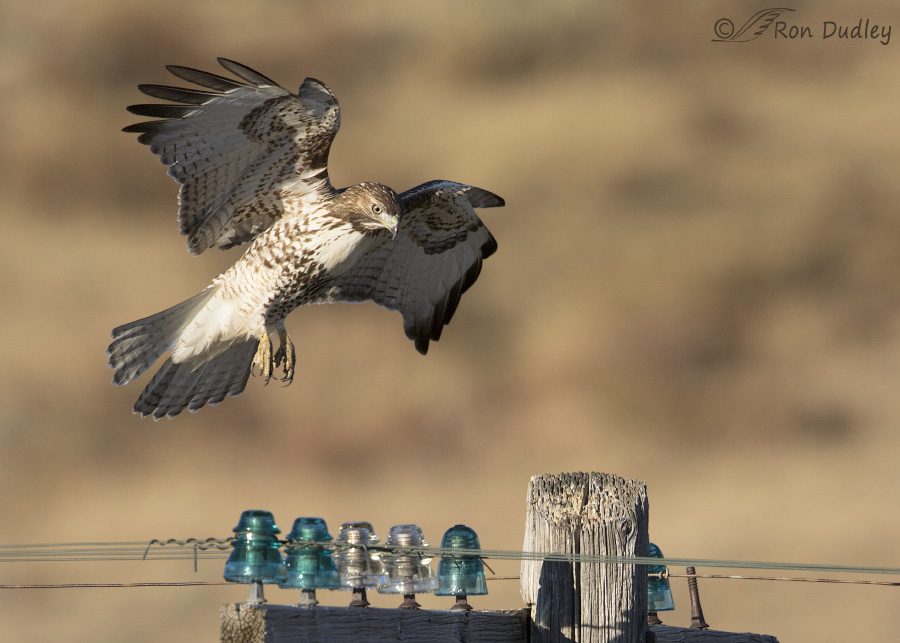
1/2000, f/6.3, ISO 500, Canon 7D Mark II, Canon EF 500mm f/4L IS II USM + EF 1.4 III Extender, not baited, set up or called in
I posted this first image as a standalone while I was still on the road but decided to include it here to make the series more complete. I had watched the hawk launch after prey from this pole and guessed that it might return to the same perch so I prefocused on the pole and waited for the hawk to come back. It obliged me.
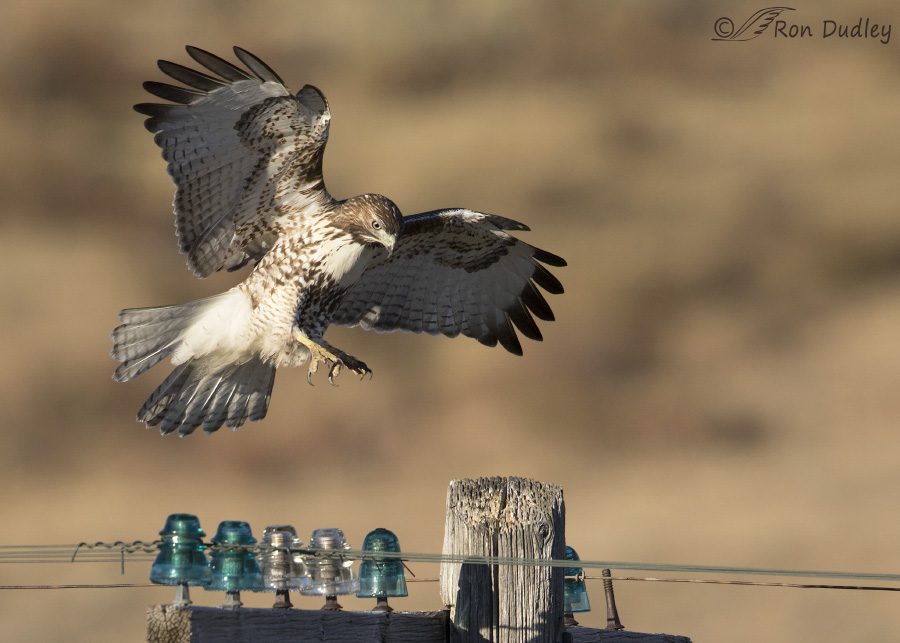
1/2000, f/6.3, ISO 500, Canon 7D Mark II, Canon EF 500mm f/4L IS II USM + EF 1.4 III Extender, not baited, set up or called in
A slight headwind slowed the bird down so I was able to get more approach shots than I expected to. I assumed there was a missing feather to explain the gap we see in the tail but in my previous post falconer Laura Culley counted them and in a comment said that the normal number of twelve feathers was present so the bird must just be holding its tail a little strangely.
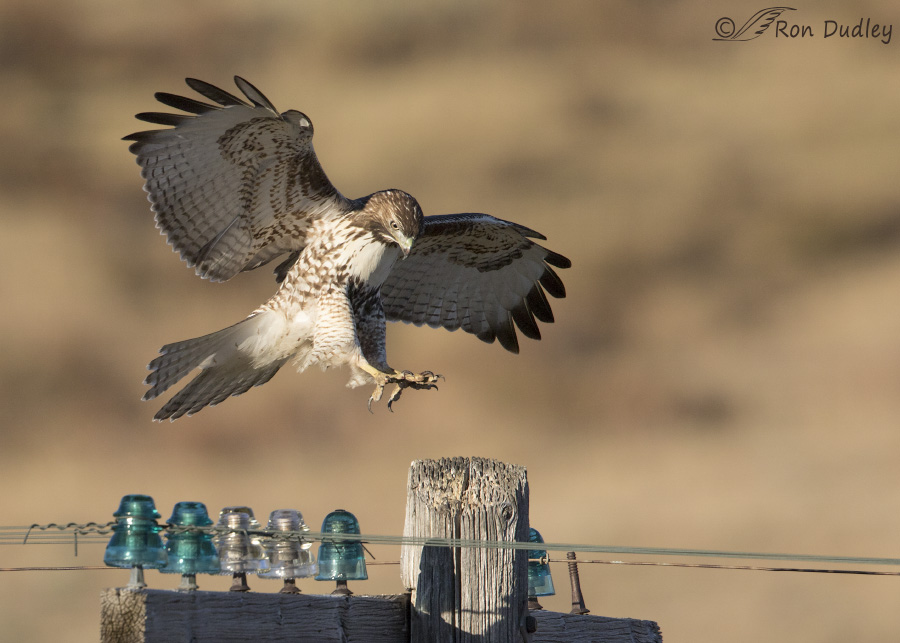
1/2000, f/6.3, ISO 500, Canon 7D Mark II, Canon EF 500mm f/4L IS II USM + EF 1.4 III Extender, not baited, set up or called in
Here I enjoy the outstretched talons as the bird prepares to settle down on the pole.
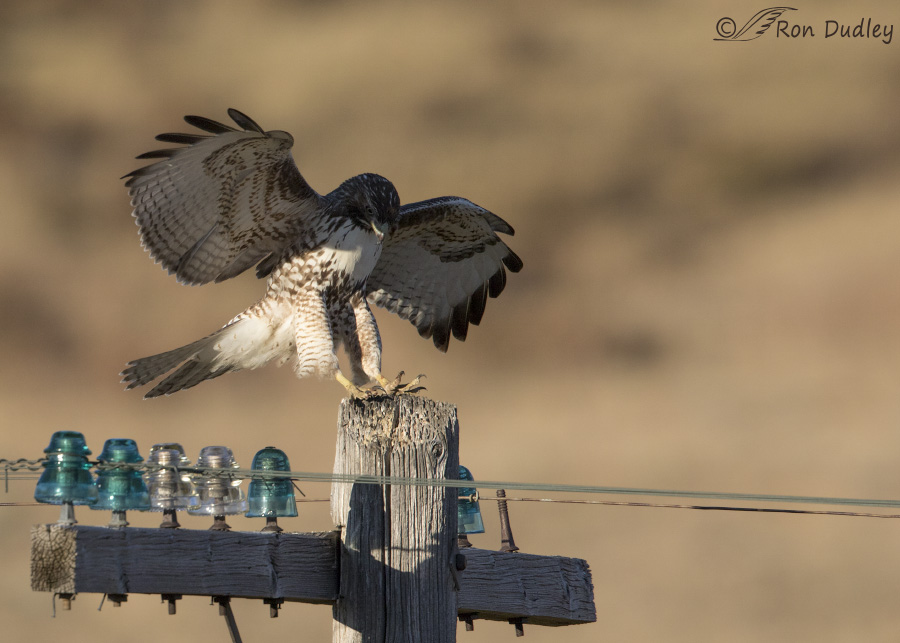
1/2000, f/6.3, ISO 500, Canon 7D Mark II, Canon EF 500mm f/4L IS II USM + EF 1.4 III Extender, not baited, set up or called in
Wouldn’t you know it – the hawk’s face was shaded when the feet contacted the pole but I decided to include the image anyway. How could I leave out the moment of touchdown?
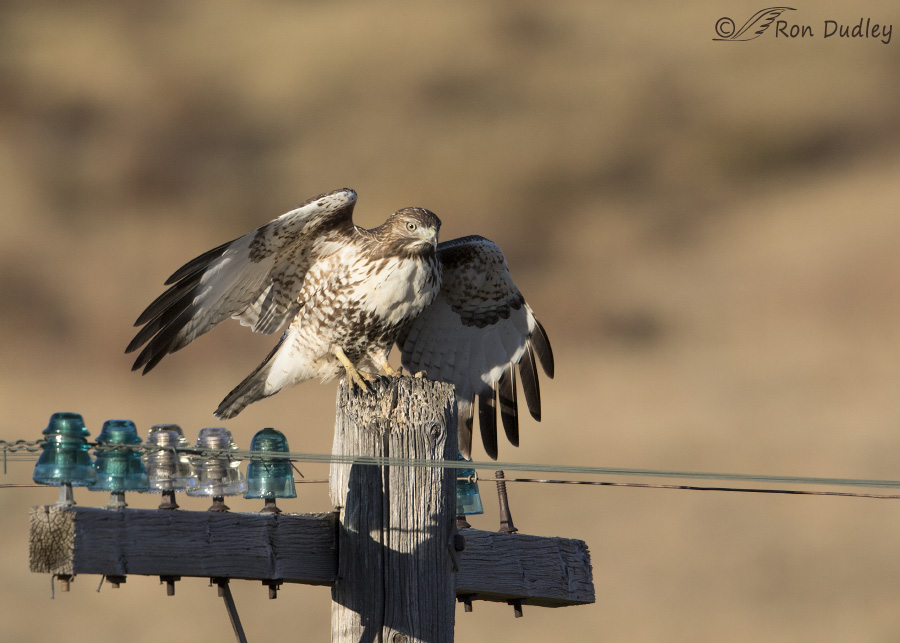
1/2000, f/6.3, ISO 500, Canon 7D Mark II, Canon EF 500mm f/4L IS II USM + EF 1.4 III Extender, not baited, set up or called in
Then the bird began to fold in its wings and soon continued its “sit and wait” hunting routine from the pole.
In the field I was a little curious about these unusual poles (unusual because they’re extremely old, uncommonly short and they have those old-fashioned glass-like insulators) but good friend and renowned raptor expert Jerry Liquori immediately recognized them as being “railroad poles”. He said they support very low voltage signal lines that often are no longer used by the railroads. These poles were running parallel and very close to railroad tracks. I thought it interesting that the insulator on the right was missing. Perhaps it was shot at by vandals – a common practice when I was a kid growing up in Montana in the 50’s.
- And speaking of Jerry Liguori – he is selling his Canon EF 500mm f/4L IS USM lens. This is the older version of the lens I have now but I used that lens for years (most of the images I’ve posted on Feathered Photography over the years were taken with that lens) and it’s a superb piece of glass. Readers often ask me for lens recommendations and this one has my highest (this lens doesn’t come on the market very often). If anyone’s interested Jerry can be contacted at jliguori@hawkwatch.org.
In closing I have to include an image of a different Red-tailed Hawk I took while it was perched on yet another one of these same railroad poles.
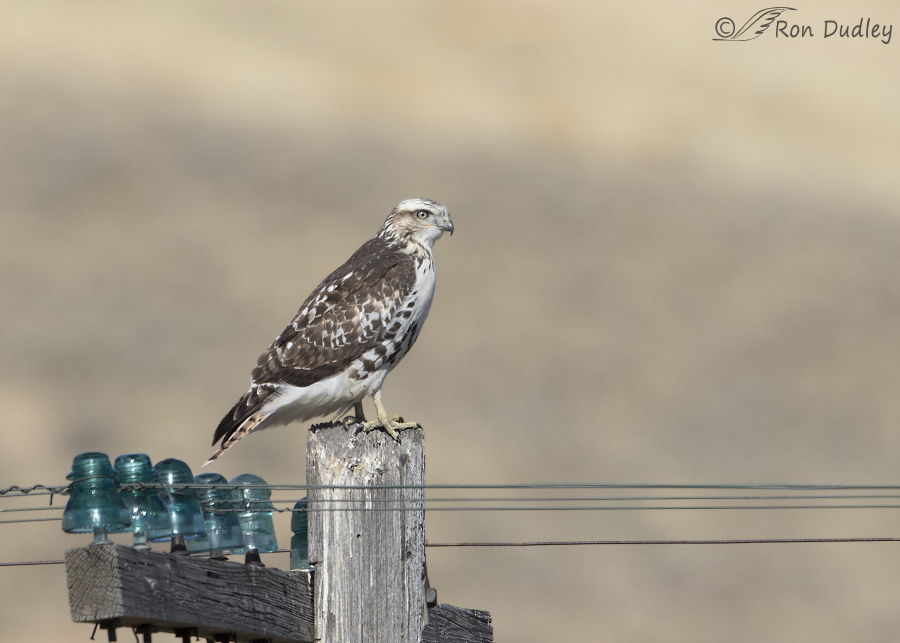
I was struck by the light coloration of the bird. Red-tailed Hawks are known for their highly variable colors and plumage patterns and I’m used to seeing that variation in the field with this species but this bird stuck out for me so I thought others might be interested in seeing it too.
Ron


Incredible
So beautiful and so good Ron…blown away by the color, lighting and topic. The insulators are icing on the cake…thanks.
I remember that you said you used to collect insulators, Zaphir, and how much you enjoyed them. I thought of you while I was composing this post.
This summer we took the train from Fairbanks to Anchorage and noticed the abandoned falling down poles paralleling the tracks with beautiful glass insulators. Now we know why they were there. Thanks, John
We also took that train but from Anchorage to Fairbanks and were told it was for the telegraph. We also were told the missing wire which was copper was removed by a contractor who also was going to remove the poles, but took the cooper wire and left town.
Sounds like an honorable kind’a guy, doesn’t he, Steven???
You’re welcome, John.
Oh my. Learning all the time. I had never realised (considered?) that there is a ‘normal’ number of tail feathers. Perhaps in my ill educated way I thought that it varied with the size of the bird?
I am so grateful to you and your commentators for continuing to drag me from the abyss of ignorance.
I learn as much here as you do, EC. That’s part if reason I blog…
Yep, the have 12 tail feathers, 10 primary wing feathers (the ones from the tip of the outstretched wing to the middle), 12 secondaries (from the middle of the wing to the body) and three tertials (right up against the body). Each year, I get a do-it-yourself, build-a-redtail and Harris’ hawk kit–everything there but the life part.
And here’s another little detail. The sum of their feathers weighs more than the sum of their skeleton! That’s a function of flight, but AMAZING!
And I’m delighted to announce that Skye (female Kestrel) FINALLY got her round tuit with growing tail feathers. At the end of August, she decided to grow two, then a third, and then it was Katy Bar the Door–ALL of them started coming out. They’re nearly finished now and I’m holding my breath that she’s not going to break them again!! I’ve changed everything. Of course, I came home from a two-hour trip to the dog park to find that she’d tangled her leash in the way it’s just not possible to tangle it–as if she’s doing somersaults inside her jesses. But there it was. Luckily, she hadn’t had enough time to REALLY get it done, so no damage.
I like to watch for the moment birds look down as they land for a quick instance then quickly look up and around as if to see is anyone or thing watching.
As do I, April.
Impressive sequence. Highway 287 between Dallas/Ft.Worth and Amarillo once had the railroad poles with insulators, and each year when we drove the route to visit our sons in
Denver, there were fewer and fewer of the insulators. I learned that they were collector items and sold in flea markets. Now the leaning poles, insulators, and dangling lines have all been removed and 287 has lost some of its mystique. The small towns still have more silos than steeples and in winter I see more Northern Harriers on this route than any other area that I travel regularly.
Dave, I hope “progress” doesn’t reach this area anytime soon and those poles are around for a good long time. They’re great perches to shoot birds on because they’re so low.
Nice series…must be good hunting from that pole to be so attractive to hunters looking for prey.
I have absolute proof that my evil iPad hates me. My screen saver has always been a serene meadow with with wild flowers and interesting clouds. It has changed itself into a scene of a road winding off into the distance and flanking it, coming right toward me, a detailed view of a 3-strand BARBED WIRE FENCE!!! How ironic is that!!!
Geez, Patty – absolutely the worst scene for you. Bet your daughter can fix it for you…
I sure as heck hope so!!!
Proof positive that the iPad is evil.
Wonderful series! It is too bad about the shaded head in the touch down shot, but it was definitely worth including. Those glass insulators used to be very collectible by people who like antiques (don’t know if they still are).
Susan, based on some of the comments on my previous post of this bird I’d say this type of insulator is still highly collectible.
Hmmm…I seem to have had a lapse in intelligence. I’m wondering if I did the tail-feather count before I’d had my coffee while I was still functionally asleep. In recounting and recounting again, I only see 11 now. What’s up with that? I think I mistakenly thought one of those tail feathers was really two, one just behind another. Sigh! Once again, I’ve proved I’m only human…LOL!
I’ve always loved the diversity of redtails, but it can drive you crazy if you let it–if you insist upon putting them in any sort of box like the biggies of Krider’s, Harlan’s, melanistic, leucistic and all the other subcategories. I think it’s best just to sit back and celebrate their diversity and stunning beauty. Just go with it
Laura, I also thought (maybe even still think) I saw 12 feathers in that second shot. The feather on the bird’s far left side looks like it might be largely hidden by the second feather. But hell, I’m about half blind and an ignoramus when it comes to bird plumages…
Great series, Ron.:) The color difference is striking and would almost think it was a different bird! Thx for the series!
I actually thought it looked a little like a Krider’s Red-tail but as far as I know they’re unknown west of the Rockies (I was very near the Continental Divide). I’m pretty sure it isn’t a Krider’s but I sure thought it was an interesting bird.
Wonderful series Ron!
Charlotte
Thanks, Charlotte.